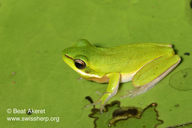|
Distribution and Habitat
Country distribution from AmphibiaWeb's database: Australia. Introduced: Guam.
Coast and adjacent areas from northern Queensland to southern New South Wales.
The extent of occurrence of the species is approximately 297700 km2.
Life History, Abundance, Activity, and Special Behaviors
Usually found in vegetation bordering swamps, streams, lagoons, ponds and farm dams often in
large numbers. In the day it shelters in the leaf-axils of pandanus and other plants away from the
water. Breeding begins with the summer rains. Small clumps of eggs are laid attached to submerged
vegetation.
Trends and Threats
No known declines and extent of occurrence > 20,000km2.
Threats
Loss of habitat from human development and habitat degradation.
Conservation Measures
Protected where the species occurs in National Parks, e.g. Fraser Island.
Comments
This species was featured in News of the Week 6 May 2024:
Plants have a variety of strategies to disperse their seeds. For instance, many species utilize animals to help cast their seeds across larger distances than is possible by wind dispersal alone. Often this involves the production of edible fruit surrounding one or more seeds, the consumption of which by animals results in the seeds being passed some distance from the source tree. Frogs, which rarely consume vegetable matter, are among the least likely candidates for seed dispersal; surprisingly, Gould and Valdez (2024) document Australian Litoria fallax potentially serving just this role. Approximately 30% of frogs in their study population had seeds of the broad-leaved cumbungi plant, Typha orientalis, adhered to their moist skin. Individual frogs were found with up to 14 of these small seeds, which are filamentous in form and typically wind pollinated, attached to their skin. This study highlights a previously unknown plant-amphibian interaction, and showcases the small but real possibility of frog-mediated dispersal involving other plant and amphibian species. (Jim McGuire)
References
Barker, J., Grigg, G. C., and Tyler, M. J. (1995). A Field Guide to Australian Frogs. Surrey Beatty and Sons, New South Wales.
Cogger, H.G. (1992). Reptiles and Amphibians of Australia. Reed Books, New South Wales.
Originally submitted by: Jean-Marc Hero et. al. (first posted 2002-04-05)
Edited by: Ambika Sopory (2024-05-05)Species Account Citation: AmphibiaWeb 2024 Litoria fallax: Eastern Dwarf Tree Frog <https://amphibiaweb.org/species/1249> University of California, Berkeley, CA, USA. Accessed May 19, 2024.
Feedback or comments about this page.
Citation: AmphibiaWeb. 2024. <https://amphibiaweb.org> University of California, Berkeley, CA, USA. Accessed 19 May 2024.
AmphibiaWeb's policy on data use.
|





 Map of Life
Map of Life